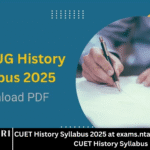The Common University Entrance Test (CUET) has become a pivotal exam for students seeking admission to various undergraduate programs across central and participating universities in India. History, being a popular subject under the CUET domain, attracts numerous aspirants every year. Understanding the CUET History Syllabus 2025 is essential for candidates aiming to excel in this examination.
This article covers the complete syllabus for CUET History 2025, key topics, exam pattern, preparation tips, and frequently asked questions to guide students in their preparation journey.
What is CUET?
The Common University Entrance Test (CUET) is an all-India level entrance examination conducted by the National Testing Agency (NTA). It is the gateway for admission into various undergraduate courses offered by Central Universities and other participating institutions.
CUET provides a standardized platform for admission, reducing the need to appear for multiple university-specific entrance tests.
Overview of CUET History Syllabus 2025
The CUET History syllabus for 2025 is designed to assess the candidate’s knowledge and understanding of historical events, developments, and cultural evolution from ancient times to the modern era. The syllabus includes topics from Indian history as well as world history to ensure a comprehensive evaluation.
The syllabus broadly encompasses:
- Ancient, Medieval, and Modern Indian History
- World History covering major civilizations and events
- Art, Culture, and Heritage related to historical developments
Where to Download CUET History Syllabus 2025?
Candidates can download the official CUET History syllabus from the National Testing Agency’s official website:
The syllabus is available in PDF format and provides detailed information on topics and subtopics to be covered in the exam.
Detailed CUET History Syllabus 2025
The syllabus is divided into major segments for structured preparation:
Ancient Indian History
- Prehistoric Cultures: Paleolithic, Mesolithic, Neolithic Ages
- Indus Valley Civilization
- Vedic Period: Early and Later Vedic Age
- Mahajanapadas and Rise of Kingdoms
- Mauryan Empire: Administration, Economy, and Society
- Post-Mauryan Period: Shunga, Satavahana, Kushanas, Guptas
- Society, Culture, and Religion: Jainism, Buddhism, Vedic Religion
Medieval Indian History
- Early Medieval Period: Rajputs, Chalukyas, Pallavas
- Delhi Sultanate: Establishment and Administration
- Mughal Empire: Akbar, Jahangir, Shah Jahan, Aurangzeb
- Regional Kingdoms: Vijayanagara, Bahmani Sultanate, Marathas
- Bhakti and Sufi Movements
- Socio-Economic Conditions and Culture in Medieval India
Modern Indian History
- Advent of European Powers in India
- British East India Company and Expansion
- Revolt of 1857: Causes and Consequences
- Indian National Movement: Early Nationalists, Extremists, Gandhian Phase
- Social and Religious Reform Movements
- Indian Constitution: Formation and Features
- Post-Independence India: Key Developments
World History
- Ancient Civilizations: Mesopotamia, Egypt, Greece, Rome
- Medieval Europe: Feudalism, Renaissance, Reformation
- Age of Discovery and Colonization
- French Revolution and its Impact
- Industrial Revolution
- World Wars: Causes, Course, and Consequences
- Cold War and Post-Cold War Era
Art, Culture, and Heritage
- Indian Art Forms: Sculpture, Architecture, Paintings
- Monuments and Heritage Sites
- Literature and Performing Arts in Different Periods
- UNESCO World Heritage Sites in India
CUET History Exam Pattern 2025
Understanding the exam pattern is key to efficient preparation.
- Mode of Exam: Computer-Based Test (CBT)
- Type of Questions: Multiple Choice Questions (MCQs)
- Total Marks: Usually 100 (check official notification)
- Duration: Approximately 90 minutes
- Marking Scheme: +1 for correct answers; no negative marking (verify official info)
- Sections: The History paper focuses exclusively on history-related topics as per the syllabus.
Preparation Tips for CUET History 2025
Familiarize with the syllabus: Download the official syllabus and divide topics into manageable segments.
Create a study schedule: Allocate dedicated time daily for history preparation.
Refer to standard textbooks: NCERT History books (Class 11 and 12) are excellent resources.
Make concise notes: Summarize each topic for quick revision.
Practice previous year papers and mock tests: This helps in understanding question patterns and improving speed.
Focus on timelines and key events: Make charts or flashcards for dates and events.
Watch documentaries and lectures: Visual learning aids retention.
Revise regularly: History requires consistent revision to remember facts.
Recommended Books for CUET History Preparation
- NCERT Class 11 & 12 History Textbooks
- India’s Struggle for Independence by Bipan Chandra
- Ancient India by R.S. Sharma
- Medieval India by Satish Chandra
- World History by Arjun Dev
- A Brief History of the World by H.G. Wells
Frequently Asked Questions
Where can I download the official CUET History syllabus for 2025?
The official syllabus is available at the National Testing Agency’s website.
Does the CUET History syllabus include world history?
Yes, the syllabus includes both Indian and world history topics.
What is the exam pattern for CUET History?
The exam is a computer-based test with multiple-choice questions focusing on the history syllabus.
Are NCERT books sufficient for CUET History preparation?
Yes, NCERT books are highly recommended as they cover most syllabus topics comprehensively.
Is there negative marking in CUET History exam?
Typically, CUET does not have negative marking, but candidates should verify the latest exam instructions.
How much time should I allocate daily for history preparation?
Depending on your schedule, 1-2 hours daily with consistent revision is advisable.
Will the CUET History exam include questions on Indian culture and art?
Yes, art, culture, and heritage are an important part of the syllabus.
Conclusion
The CUET History Syllabus 2025 is designed to assess a candidate’s understanding of Indian and world history comprehensively. By following the detailed syllabus, adhering to a disciplined study routine, and utilizing recommended resources, aspirants can enhance their chances of success.For updated information and official notifications, always refer to the official NTA website: .Start your preparation early, stay consistent, and approach the exam with confidence. Best of luck!

